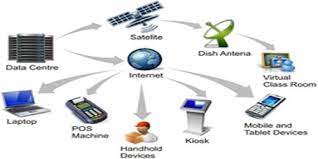A transaction processing system (TPS) is a computer-based system that automates the execution and recording of routine business transactions. This article will teach us what a transaction processing system is, with some of its examples and types, also we will be understanding the characteristics displayed by it.
Transaction Processing System
A transaction processing system (TPS) is an information processing system for business transactions that gathers, alters, and retrieves all transaction data. A transaction processing system possesses the following characteristics: performance, dependability, and consistency. TPS is also in link to transaction processing or real-time processing.
In other words, by isolating application programs from the intricacies of transaction management, a TPS enables application programmers to concentrate their efforts on writing code that benefits the business: It manages the concurrent processing of many transactions. It also enables the sharing of data. It thus safeguards data from manipulation.
Components of a Transaction Processing System
Each Transaction Processing System, however, has four essential components that enable it to function properly:
#1. Input
An input is a product request or payment that is payable to a company’s TPS by a third party. Hence, if your organization employs batch processing, your TPS will save and process groups of inputs. In comparison, if your business makes use of a real-time system, each input is processed in real-time. Typical inputs include the following:
- Invoices
- Bills
- Coupons
- Custom orders
#2. Output
The outputs of a TPS are the documents that the system generates once all of the inputs have been processed. This may include receipts stored in the business’s records. These documents may be useful in verifying a sale or transaction. Additionally, they can be a significant source of information for tax and other government-related purposes. If a vendor submits an invoice to your business, for example, you can pay the invoice and provide payment confirmation to the vendor. Once revised, the original invoice can be listed as “paid” in the company’s TPS.
#3. Storage
The storage component of TPS relates to the location of a business’s input and output documents or digital information. However, certain businesses maintain these records electronically in a database. The storage component thus ensures that each document is properly in order, safe, and retrievable for future use. If a vendor wishes to confirm that your company has paid an invoice, for example, you can search for the invoice in your system’s storage and determine whether you made a payment.
#4. Processing
The processing component of the system is responsible for reading each input and generating a useful output, such as a receipt. This element can also be useful to define the input and output data. Processing timeframes hence vary according to the type of TPS used by your business.
Transaction Processing System Examples
In learning about transaction processing systems, there are some examples we provide for you to help understand the process it takes. Below are the transaction processing examples.
Examples of Real-Time Transaction Processing System
#1. Reservation Systems
- Useful in any industry where a product or service is held for a specific customer (E.g layby, train tickets)
- Establish a requirement for a fair response time.
#2. Point-of-sale terminals
- It is useful for retail establishments to sell goods and services.
- It reduces the expense of mass data handling by converting data to a format that can be easily sent via a communication system.
- After entering the product number, the proper pricing for the product is returned.
#3. The library’s loan system
- Useful to keep track of borrowed items.
- The user’s card and the item’s barcodes are scanned.
- You store the data in a database.
- Analogous to reservations systems (involves keeping product, availability, usage, and maintenance information),
- Frequently, a warehouse is useful to store products.
Examples of Batch Transaction Processing System
#1. Cheque Clearance
- A written instruction to a bank directing that funds be transferred to a designated account.
- They are deposited into people’s bank accounts.
- It requires confirming that the individual has the appropriate financial resources (which takes up to 3 days).
- Money is withdrawn after a check is cleared.
#2. Credit Card Transactions (Manual)
- An impression of the credit card is made on a credit slip, which is subsequently filled up by a sales clerk.
- The bank receives all impressions collectively.
- Not processed immediately
- Customers can view real-time credit card transactions, although the data are updated in batches.
What is a Transaction Processing System?
A Transaction Processing System (TPS) is a type of information system that collects, stores, modifies, and retrieves data transactions for an enterprise. Additionally, transaction processing systems strive to maintain predictable response times to requests, albeit this is less critical than it is in real-time systems. Rather than allowing the user to run any app in time-sharing mode, transaction processing supports only specified, ordered transactions.
By storing, sending, and receiving data through a database, the transaction processing system (TPS) further ensures the success of each transaction. It also integrates with the business’s point of sale system, or POS, which processes credit cards, prints receipts, and accepts and retains cash. An online transaction processing system is thus an online retailer’s counterpart to an e-commerce system.
Benefits of Using a Transaction Processing System
The following are some of the most common benefits of using a TPS:
#1. Increased Transaction Speed
With a TPS in place, businesses may effectively increase both the speed of each transaction and clients’ wait times. The rate at which a business processes transactions, varies according to the type of TPS used. While some systems execute transactions immediately, others accumulate transaction data over time and process it later, typically after business hours.
#2.Cost-Effectiveness Increased
Utilizing a TPS can assist a business in saving money, increasing both transaction cost-effectiveness, and archiving data in a database. A TPS may conduct and organize thousands of transactions during the day. This can thus save the business money by avoiding the need for system upgrades or the utilization of several systems to meet demand.
#3. Improved Reliability
The reliability of transaction processing systems is a critical attribute. However, utilizing a TPS enables you to ensure that consumer transactions are in execution, quickly and accurately. Additionally, a reputable TPS can save your business money on future troubleshooting and coding charges associated with faulty systems.
#4. Automated Management
A corporation’s TPS enables the automation of the majority of its internal resource and revenue management. However, by increasing automation, the TPS can decrease the amount of time staff spend evaluating transactions. Automation is vital for increasing a company’s profitability since it frees up individuals to focus on interesting occupations that require critical thinking.
Types of Transaction Processing System
It’s now time to understand the types of transaction processing system, which is divided into two kinds. The processing in a batch and also the processing in real-time. Let us now take a look at them.
Processing in a Batch
Batch processing is a technique that can be useful for collecting and processing data in large amounts. When it is easier or more cost-effective, transactions will be gathered and updated in batches. This was the most common method in the past due to the lack of real-time processing capabilities in information technology.
Batch processing is exemplified by a monthly membership service. Because the transactions occur concurrently, the system processes them as a batch at the end of the month when each client pays for a service. Because the system scans batches just once a month, a lag in transaction processing is acceptable in this circumstance.
Processing in Real-Time
In types of other transaction processing systems, it is the real-time processing of data. It permits quick confirmation of transactions. It may entail a large number of users performing data-changing transactions concurrently. Thanks to technical developments, real-time updating is now possible. For example, an e-commerce website may use a TPS to process credit card transactions in real-time to validate payment before initiating the fulfillment process.
Characteristics of Transaction Processing System
The four important characteristics of a transaction processing system include:
#1. Rapid Response
Rapid response is very important for rapid performance is critical and also The time required to complete a transaction from input to output must be a few seconds or less.
#2. Reliability
In reliability, the transaction processing system, however, helps to breakdowns cause operations to be disrupted. It also minimizes the rate of failure, and In the event of an error, you must be able to recover swiftly and precisely.
#3. Inflexibility
Each transaction must be treated uniformly. Not only that, its flexibility results in an overabundance of non-standard operations that can create complications due to data inconsistencies.
#4. Controlled Processing
The transaction processing system must assist an organization’s operations, and If assignments of duties and responsibilities are made, the TPS should guarantee that they are carried out.
Transaction Processing System Importance
The following are the key importance of the TPS;
#1. Exploiting the Raw Markets
TPS is a crucial tool for any business because it allows firms to function in all parts of society through remote work. Thus the business is opportune to tap into, operate in, and grow in newer markets that are raw and full of opportunities.
#2. Handling and Managing Operations
The transaction processing system enables multitasking on a larger scale, with an unrivaled ability to perform thousands of transactions at the same time without delay or failure. In all, TPS is a useful tool in handling and controlling an organization’s day-to-day activities.
What Is Transaction Processing System Used For?
A transaction process system (TPS) is an information processing system for business transactions that gathers, alters, and also retrieves all transaction data. A Transaction Processing System possesses the following characteristics: performance, dependability, and consistency. TPS is therefore often referred to as transaction processing or real-time processing.
What Are the Types of Transaction Processing System?
The processing in a batch and the processing in real-time, are the two types of the transaction processing system.
Processing in a batch
Processing in real-time
How Does Transaction Processing Work?
By storing, sending, and receiving data through a database, the transaction processing system (TPS) thus, ensures the success of each transaction. It also integrates with the business’s point of sale system, or POS, which processes credit cards, prints receipts, and accepts and retains cash. An OTPS, or online transaction processing system, is, however, an online retailer’s counterpart of an e-commerce system.
What Are the Advantages of Tps?
When you use a TPS, you can make sure that customer transactions are handled quickly and correctly. A reliable TPS can also help your company save money on troubleshooting or coding costs for systems that don’t work right.
What Are the Steps in the Transaction Processing System?
A transaction is processed in six steps. They are data entry, data validation, data processing and revalidation, data storage, output generation, and query support.
What Is the First Rule of Tps?
There are very clear expectations for everything that must be done, including its substance, its progression, its duration, and its final result. This makes sense, and even makes sense, but how often can we say that about the way we deliver health care? In reality, both in and out of the medical field, procedures and standards are typically described in broad strokes.
What Is a Disadvantage of Tps?
It is imperative that TPS be tailored specifically to the requirements of the company or organization. Costs associated with implementing TPS could be high. The TPS method is not standardized. Hardware and software incompatibilities are a potential stumbling block during TPS installation.
- ONLINE PAYMENT SYSTEMS: Top 13 Online Payment Systems & Software in the UK
- CHEAPEST & FREE PAYROLL SERVICES FOR SMALL BUSINESS 2023 (Updated)
- Debt To Equity Ratio: Explained!!!, Formula, Calculations, Examples
- Prescriptive Analytics Tools & Techniques: 9+ Best 2023 Options
- NET 30 PAYMENT TERMS: Meaning, Examples & Reasons Why You Should Use Them or Not
- ORDER TO CASH PROCESS: A Detailed Guide






